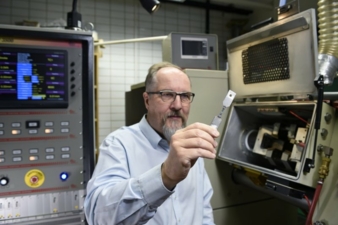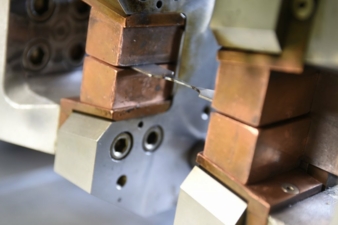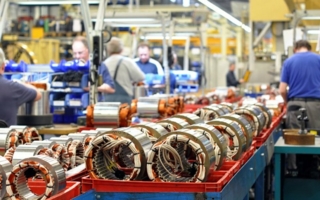17/02/2023 – University of Oulu receives 1.6 million euros to expedite emission-free steel industry
Expertise for a completely emission-free steel mill
The Tiina and Antti Herlin Foundation’s significant four-year funding will be allocated to steel research and the promotion of carbon neutrality in the steel industry, which is important for Finland. The objective is to create a completely emission-free steel mill.
The Advanced Steels for a Green Planet (AS4G) project funded by the Tiina and Antti Herlin Foundation started in January 2023. The project will focus on processing the end results of an emission-free steel mill – the utilisation of side streams and the manufacturing of ultra high-strength steels, in particular.
“It’s important to focus research on the themes where emissions can be decreased the most and where the strengthening of expertise creates the most benefits,” says Jukka Kömi, Professor at the University of Oulu. “The aim is to enable expertise for a completely emission-free steel mill in 2050.”
“In terms of carbon dioxide, achieving an emission-free steel mill in the Nordics will be realistic as early as 2035. It’s also important that future steel mills will not generate waste, but that all created side streams will be utilised as raw material in different sectors,” says Mirja Illikainen, Dean of the Faculty of Technology and Professor of inorganic materials in circular economy at the University of Oulu. “Slag from current steel production is utilised well, but we still need development for the slag that will be created in carbon-free steel production.”
The carbon dioxide emissions of steel applications can be cut by decreasing and strengthening the steel used in them. Ultra high-strength steel makes structures lighter, which means that moving, for example, trucks, ships and trains requires less fuel. For instance, the carbon dioxide emissions of Finland could be cut by up to eight percent if high-tensile steel was used in trucks.
“We study and review on an atomic level how high- strength steel works,” Kömi explains. “We have to know how atoms interact and what makes steel high-tensile. Steel always has a lot of impurities, which is why it must be understood exactly what can be alloyed into it to make the end result even stronger.”
Forging future steel, circular economy and hydrogen
“With basic research, we focus on steel development so that efficient supply chains can be designed for steel mills. Operational excellence must be constantly developed to understand how different grades of steel behave, as the same steel won’t work in a wind power plant, a ship and a bridge,” Kömi describes.
The AS4G project is committed to the development of sustainable solutions and principles of circular economy, which will create new business opportunities for many sectors connected to the steel industry.
“Slag from steel production often contains plenty of chemical elements that make them interesting alternatives for cement, for example,” Illikainen explains. After water, concrete is the most used material in the world, and the production of its key raw material, cement, is the single largest source of human-caused carbon dioxide emissions. The production of construction materials that preserve the environment offers new competitive advantages for companies.
The development of lightweight steel structures is expedited by the automotive industry, because lighter cars must be strengthened in different ways while ensuring their safety. High-tensile steel is necessary for protecting the heavy batteries of electric cars, and it is also needed for the chassis – to make them functional.
The new AS4G project will be a unique combination of multidisciplinary expertise from the research of advanced steels, basic physics, metallurgy and the utilisation of industrial side streams. In addition, emission-free steel production is being developed with the help of ground-breaking hydrogen innovations, for example, in producing hydrogen directly with sunlight without massive energy consumption. The use of hydrogen as a reductant in steel production could cut Finland’s emissions by up to seven per cent. Read more about the research on future hydrogen economy and sustainable steel production.
Rapid cutting of carbon dioxide emissions
The work of the Tiina and Antti Herlin Foundation currently focuses on increasing the demand for carbon-neutral steel with a comprehensively sustainable approach. According to the foundation’s environmental programme, the supported projects aim at promoting the interconnection of the most promising solutions, because there is no one innovative method that would guarantee the transition of an entire industry.
“The project we are funding is an excellent example of internationally significant steel research where the lessons learned in the project can be efficiently put into practice in the surrounding circular economy, hydrogen and metal industry. The development of high-strength steel, for example, can open up a large new market for green steel in the construction industry. It’s also important for the funding sector to learn to identify these multi-sector ecosystems in order to sufficiently lower the total emissions of the steel sector fast,” says Harri Lammi, Head of Environmental Projects at the Foundation.
The Tiina and Antti Herlin Foundation will be funding the University of Oulu’s steel research by an annual amount of euro 400,000 for four years.
The University of Oulu is one of Finland’s biggest and most multidisciplinary universities. We work as part of the international science community and create new knowledge and innovations that help to solve global challenges. We also educate future pioneers for the needs of the changing world and offer a wide range of degree programmes that are taught in English. The University of Oulu is ranked in the top 3% of the world´s universities. https://www.oulu.fi/en/media
University of Oulu
Materials and Mechanical Engineering Research Unit
Pentti Kaiteran katu 1
Oulu, Pohjois-Pohjanmaa 90014, Suomi
Contact person is Jukka Kömi
Tel.: +358 40 5490-311
jukka.komi@oulu.fi
www.oulu.fi



